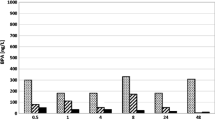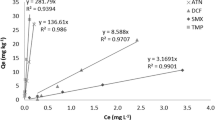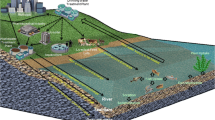Abstract
Sorption–desorption behavior of the antibiotic tetracycline (TET) and the synthetic estrogen hormone 17α-ethinylestradiol (EE2) with wastewater sludge and sludge-derived humic substances [humic acid (HA) and humin] was investigated. From acidic functional group capacity and elemental analyses, HA had higher polarity, aromaticity, and acidity than humin; humin contained aliphatic chains with high mineral content. The different physicochemical properties of the pharmaceuticals and sludge components yielded different kinds of sorption–desorption interactions. Partitioning coefficients (K d) of TET to sludge were higher (1,552 ± 41–4,667 ± 41 L/kg) than EE2 (534 ± 52–609 ± 47 L/kg). TET sorption was highly pH-dependent and maximal at pH 9. Ca2+ ions enhanced sorption, emphasizing the role of polyvalent metal ions in forming TET–sludge complexes. Humin was the dominant component for TET sorption due to its high inorganic matter content. In contrast, EE2 sorption was independent of solution pH, forming mostly hydrophobic interactions with sludge organic matter. EE2 had a high affinity for HA due to its chemical structure. Desorption of the two pharmaceuticals differed as well. The amount of desorbed TET (18.7 ± 1.3–29.8 ± 2 %) was lower than that of EE2 (60.6 ± 3–62.3 ± 2 %), and the hysteresis index was higher for TET than EE2. While TET desorption tended to be delayed in the solid matrix, EE2 desorbed easily and in accordance with the aqueous equilibrium concentration. The conclusions emphasize the need for further research into frequently used pharmaceuticals with different physicochemical properties and the recognition of sludge application as an important source of distribution for these contaminants in the environment.




Similar content being viewed by others
References
Andersen, H. R., Hansen, M., Kjolholt, J., Stuer-Lauridsen, F., Ternes, T., & Halling-Sorensen, B. (2005). Assessment of the importance of sorption for steroid estrogens removal during activated sludge treatment. Chemosphere, 6, 139–146.
Anderson, C. R., Rupp, H. S., & Wu, W. H. (2005). Complexities in tetracycline analysis—chemistry, matrix extraction, cleanup, and liquid chromatography. Journal of Chromatography A, 1075, 23–32.
Auerbach, E. A., Seyfrid, E. E., & McMahon, K. D. (2007). Tetracycline resistance genes in activated sludge wastewater treatment plants. Water Research, 41, 1143–1151.
Avisar, D., Levin, G., & Gozlan, I. (2009). The processes affecting oxytetracycline contamination of groundwater in a phreatic aquifer underlying industrial fish ponds in Israel. Environmental Earth Sciences, 59, 939–945.
Avisar, D., Primor, O., & Mamane, H. (2010). Sorption of sulfonamides and tetracyclines to montmorillonite clay. Water, Air, & Soil Pollution, 209, 439–445.
Bowles, E. C., Antweiler, R. C., & MacCarthy, P. (1989). Acid–base titration and hydrolysis of Suwannee River, Georgia; interactions, properties and proposed structures. U.S Geological Survey Open File Rep. no. 87–557. Denver: U.S. Geological Survey.
Carballa, M., Omil, F., Llompart, M., Garcia-Jares, C., Rodriguez, I., Gomez, M., & Ternes, T. (2004). Behavior of pharmaceuticals, cosmetics and hormones in a sewage treatment plant. Water Research, 38, 2918–2926.
Chang, P. H., Li, Z., Jiang, W. T., & Jean, J. S. (2009). Adsorption and intercalation of tetracycline by swelling clay minerals. Applied Clay Science, 46, 27–36.
Chefetz, B., Mualem, T., & Ben-Ari, J. (2008). Sorption and mobility of pharmaceutical compounds in soil irrigated with reclaimed wastewater. Chemosphere, 73, 1335–1343.
Chen, Y., Li, H., Wang, Z., Tao, T., & Hu, C. (2011). Photoproducts of tetracycline and oxytetracycline involving self-sensitized oxidation in aqueous solutions: Effects of Ca2+ and Mg2+. Journal of Environmental Sciences, 23(10), 1634–1639.
Cirja, M., Zuehlke, S., Ivashechkin, P., Hollender, J., Schaffer, A., & Corvini, P. F. X. (2007). Behavior of two differently radiolabelled 17α-ethinylestradiols continuously applied to a laboratory-scale membrane bioreactor with adapted industrial activated sludge. Water Research, 41, 4403–4412.
Clara, M., Strenn, B., Saracevic, E., & Kreuzinger, N. (2004). Adsorption of bisphenol-A, 17β-estradiole and 17α-ethinylestradiole to sewage sludge. Chemosphere, 56, 843–851.
Diaz-Cruz, M. S., Lopez de Alda, M. J., & Barcelo, D. (2003). Environmental behavior and analysis of veterinary and human drugs in soils, sediments and sludge. Trends in Analytical Chemistry, 22, 340–351.
Ding, Y., Zhang, W., Gu, C., Xagoraraki, I., & Li, H. (2011). Determination of pharmaceuticals in biosolids using accelerated solvent extraction and liquid chromatography/tandem mass spectrometry. Journal of Chromatography A, 1218, 10–16.
Golet, E. M., Strehler, A., Alder, A. C., & Giger, W. (2002). Determination of fluoroquinalone antibacterial agents in sewage sludge and sludge-treated soil using accelerated solvent extraction followed by solid-phase extraction. Analytical Chemistry, 74, 5455–5462.
Golet, E. M., Xifra, I., Siergist, H., Alder, A. C., & Giger, W. (2003). Environmental exposure assessment of fluoroquinalone antibacterial agents from sewage to soil. Environmental Science and Technology, 37, 3243–3249.
Gozlan, I., Rotstein, A., & Avisar, D. (2013). Identification and determination in the aquatic environment: amoxicillin degradation products formed under controlled environmental conditions. Chemosphere, 91, 985–992.
Gu, C., Karthikeyan, K. G., Sibley, S. D., & Pederson, J. A. (2007). Complexation of the antibiotic tetracycline with humic acid. Chemosphere, 66, 1494–1501.
Halling-Sørensen, B., Nors Nielsen, S., Lanzky, P. F., Ingerslev, F., HoltenLützhøft, H. C., & Jørgensen, S. E. (1998). Occurrence, fate and effects of pharmaceutical substances in the environment. Chemosphere, 36, 357–393.
Heberer, T. (2002). Occurrence, fate, and removal of pharmaceutical residues in the aquatic environment: a review of recent research data. Toxicology Letters, 131, 5–17.
Huang, W., Yu, H., & Weber, W. J., Jr. (1998). Hysteresis in the sorption and desorption of hydrophobic organic contaminants by soils and sediments. 1. A comparative analysis of experimental protocols. Journal of Contaminant Hydrology, 31, 129–148.
Inbar, Y., Chen, Y., & Hadar, Y. (1990). Humic substances formed during the composting of organic matter. Soil Science Society of America Journal, 54, 1316–1323.
Jin, L., Amaya-Mazo, X., Apel, M. E., Sankisa, S. S., Johnson, E., Zbyszynaka, M. A., & Han, A. (2007). Ca2+ and Mg2+ bind tetracycline with distinct stoichiometries and linked deprotonation. Biophysical Chemistry, 128, 185–196.
Jobling, S., Beresford, N., Nolan, M., Rodgers-Gray, T., Brighty, G. C., Sumpter, J. P., & Tyler, C. R. (2002). Altered sexual maturation and gamete production in wild roach (Rutilus rutilus) living in rivers that receive treated sewage effluents. Biology of Reproduction, 66, 272–281.
Kim, S., Eichhorn, P., Jensen, J. N., Weber, A. S., & Aga, D. S. (2005). Removal of antibiotics in wastewater: effect of hydraulic and solid retention times on the fate of tetracycline in the activated sludge process. Environmental Science and Technology, 39, 5816–5823.
Kolpin, D. W., Furlong, E. T., Meyer, M. T., Thurman, E. M., Zaugg, S. D., Barber, L. B., & Buxton, H. T. (2002). Pharmaceuticals, hormones, and other organic wastewater contaminants in U.S. streams 1999–2000: a national reconnaissance. Environmental Science and Technology, 36, 1202–1211.
Kummerer, K. (2009). The presence of pharmaceuticals in the environment due to human use—present knowledge and future challenges. Journal of Environmental Management, 90, 2354–2366.
Lai, K. M., Johnson, K. L., Scrimshaw, M. D., & Lester, J. N. (2000). Binding of waterborne steroid estrogens to solid phases in river and estuarine systems. Environmental Science and Technology, 34, 3890–3894.
Lamm, A., Rotstein, A., Gozlan, I., & Avisar, D. (2009). Detection of amoxicillin- diketopiperazine-2′,5′ in wastewater samples. Journal of Environmental Science and Health, Part A Environmental Science, 4, 1512–1517.
Lee, L. S., Strock, T. J., Sarmah, A. K., & Rao, P. S. C. (2003). Sorption and dissipation of testosterone, estrogens, and their primary transformation products in soils and sediments. Environmental Science and Technology, 37, 4098–4105.
Loffredo, E., & Senesi, N. (2006). The role of humic substances in the fate of anthropogenic organic pollutants in soil with emphasis on endocrine disruptor compounds. In I. Twardowska, H. E. Allen, M. M. Haggblom, & S. Stefaniak (Eds.), Soil and water pollution monitoring, protection and remediation (Vol. 69, pp. 69–92). Dordrecht: Springer.
Martin, S. R. (1979). Equilibrium and kinetic studies on the interaction of tetracyclines with calcium and magnesium. Biophysical Chemistry, 10, 319–326.
Metcalf, L., & Eddie, H. P. (2003). Wastewater engineering treatment and reuse (4th ed.). New York: McGraw-Hill.
Parolo, M. E., Savini, M. C., Valles, J. M., Baschini, M. T., & Avena, M. J. (2008). Tetracycline adsorption on montmorillonite: pH and ionic strength effects. Applied Clay Sciences, 40, 179–186.
Pils, J. R., & Laird, D. A. (2007). Sorption of tetracycline and chlorotetracycline on K− and Ca− saturated soil clays, humic substances, and clay-humic complexes. Environmental Science and Technology, 41, 1928–1933.
Purdom, C. E., Hardiman, P. A., Bye, V. J., Eno, N. C., Tyler, C. R., & Sumpter, J. P. (1994). Estrogenic effects of effluents from sewage treatment works. Chemistry and Ecology, 8, 275–285.
Rice, J. A., & MacCarthy, P. (1991). Statistical evaluation of the elemental composition of humic substances. Organic Geochemistry, 17, 635–648.
Schwartz, T., Kohnen, W., Jansen, B., & Obst, U. (2002). Detection of antibiotic-resistant bacteria and their resistance genes in wastewater, surface water, and drinking water biofilms. FEMS Microbiology Ecology, 1470, 1–11.
Schwarzenbach, R. P., Gschwend, P. M., & Imboden, D. M. (2003). Environmental organic chemistry. New York: Wiley.
Shafrir, M., & Avisar, D. (2012). Development method for extracting and analyzing antibiotic and hormone residues from treated wastewater sludge and composted biosolids. Water, Air, & Soil Pollution, 223, 2571–2587.
Shareef, A., Angove, M. J., Wells, J. D., & Johnson, B. B. (2006). Aqueous solubilities of estrone, 17β-estradiol, 17α-ethynylestradiol, and bisphenol A. Journal of Chemical Engineering Data, 51, 879–881.
Sithole, B. B., & Guy, R. D. (1987). Models for tetracycline in aquatic environments I: Interaction with bentonite clay systems. Water, Air, & Soil Pollution, 32, 303–314.
Steelink, C. (1985). Implications of elemental characteristics of humic substances. In G. R. Aiken, D. M. McKnight, R. L. Wershaw, & P. MacCarthy (Eds.), Humic substances in soil, sediment and water: geochemistry, isolation and characterization (pp. 457–475). New York: Wiley.
Stevenson, F. J. (1994). Humus chemistry: genesis, composition, reactions. New York: Wiley.
Stuer-Lauridsen, F., Birkved, M., Hansen, L. P., Lützhøft, H. C., & Halling-Sørensen, B. (2000). Environmental risk assessment of human pharmaceuticals in Denmark after normal therapeutic use. Chemosphere, 40, 783–793.
Sun, K., Gao, B., Zhang, Z., Zhang, G., Liu, X., Zhao, Y., & Xing, B. (2010). Sorption of endocrine disrupting chemicals by condensed organic matter in soils and sediments. Chemosphere, 80, 709–715.
Sun, K., Jin, J., Gao, B., Zhang, Z., Wang, Z., Pan, Z., Xu, D., & Zhao, Y. (2012). Sorption of 17α-ethinyl estradiol, bisphenol A and phenanthrene to different size fractions of soil and sediment. Chemosphere, 88, 577–583.
Swift, R. S. (1996). Organic matter characterization. In D. L. Sparks, A. L. Page, P. L. Helmke, R. H. Loeppert, P. N. Soltanpour, M. A. Tabatabai, C. T. Johnston, & M. E. Sumner (Eds.), Methods of soil analysis. Part 3: chemical methods. Madison: Soil Science Society of America.
Ternes, T. A., & Joss, A. (2006). Human pharmaceuticals, hormones and fragrances: the challenge of micropollutants in urban water management. London: IWA Publishing.
Ternes, T. A., Kreckel, P., & Mueller, J. (1999). Behavior and occurrence of estrogens in municipal sewage treatment plants—II. Aerobic batch experiments with activated sludge. Science of the Total Environment, 225, 91–99.
Ternes, T. A., Andersen, H., Gilberg, D., & Bonerz, M. (2002). Determination of estrogens in sludge and sediments by liquid extraction and GC/MS/MS. Analytical Chemistry, 74, 3498–3504.
Ternes, T. A., Herrmann, N., Bonerz, M., Knacker, T., Siegrist, H., & Joss, A. (2004). A rapid method to measure the solid-water distribution coefficient (Kd) for pharmaceuticals and musk fragrances in sewage sludge. Water Research, 38, 4075–4084.
Thiele-Bruhn, S. (2003). Pharmaceutical antibiotic compounds in soil. Journal of Plant Nutrition and Soil Science, 166, 145–167.
Tools, J. (2001). Sorption of veterinary pharmaceuticals in soils: a review. Environmental Science and Technology, 35, 3397–3406.
Urase, T., & Kikuta, T. (2005). Separate estimation of adsorption and degradation of pharmaceutical substances and estrogens in the activated sludge process. Water Research, 39, 1289–1300.
Wessels, J. M., Ford, W. E., Szymczak, W., & Schneider, S. (1998). The complexation of tetracycline and anhydrotetracycline with Mg2+ and Ca2+: a spectroscopic study. Journal of Physical Chemistry B, 102, 9323–9331.
Xia, K., Bhandari, A., Das, K., & Pillar, G. (2005). Occurrence and fate of pharmaceuticals and personal care products (PPCPs) in biosolids. Journal of Environmental Quality, 34, 91–104.
Xu, X. R., & Li, X. Y. (2010). Sorption and desorption of antibiotic tetracycline on marine sediments. Chemosphere, 78, 430–436.
Yamamoto, H., Liljestrand, H. M., Shimizo, Y., & Morita, M. (2003). Effects of chemical-physical characteristics on the sorption of selected endocrine disruptors by dissolved organic matter surrogates. Environmental Science and Technology, 37, 2646–2657.
Acknowledgments
The authors gratefully acknowledge the Israel Ministry of Environmental Protection, the Israeli Water Authority, and the Porter School for Environmental Studies at Tel Aviv University for their financial support.
Author information
Authors and Affiliations
Corresponding author
Rights and permissions
About this article
Cite this article
Tenenbaum, I., Chefetz, B. & Avisar, D. Physicochemical Behavior of Tetracycline and 17α-Ethinylestradiol with Wastewater Sludge-Derived Humic Substances. Water Air Soil Pollut 225, 2155 (2014). https://doi.org/10.1007/s11270-014-2155-y
Received:
Accepted:
Published:
DOI: https://doi.org/10.1007/s11270-014-2155-y




